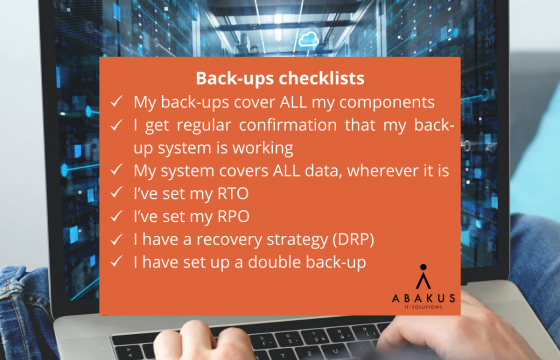
Back-ups, checklists, and all that jazz
Posted 3 Years ago
E-mails not getting sent, websites that freeze up, files going missing, disappearing orders….
Small- and large-scale incidents such as these, as well as frequent ransomware attacks, are painful reminders for many businesses of the importance of making back-ups. In addition, the main cause of data loss is usually human error. As the saying goes: better safe than sorry.
Statistics show that almost a third of users (29%) never back up their computer data, and that only 10% do so on a daily basis. Are you one of the remaining 61%? You've probably seen at least an hour’s work on your computer disappear at some point in your life. Imagine losing more: a week’s worth of coding, all your customer lists, your accounts, or access to your e-mail.
Basic advice
Before you pronounce yourself satisfied with the back-up system you have at the moment, check that it covers all the components you need: operating systems, and all your applications and data, even those you use the least, on each of your servers.
Also, make sure that someone in your business or IT company gets the success or failure messages from the back-up system. Regularly test your back-ups and the reliability of your data or, if necessary, ask your IT company to confirm that it’s doing that for you.
Setting your back-up parameters
Given all the remote working that’s been going on, it’s also possible that your data is scattered here and there: on the central computer, your employees’ laptops, your respective smartphones, or somewhere in the Cloud. Customer files, plans, invoices, e-mails sent and received, contacts, agendas and more—these are all examples of data that’s really valuable to your company. So remember to regularly make a list of the data you want to back up, and to adjust how often the back-ups are to happen.
Every half hour, every day, every week, every month? To find out, first set the recovery time objective (RTO), which is the maximum downtime your business can accept. The RTO makes it possible to assess the damage that an interruption would cause to the normal course of your operations, or even the extent of any financial losses. If the RTO for a given application is only one hour, it would be better to opt for a redundant back-up on external hard drives. If it’s three days, then tape or off-site storage may be enough.
The recovery point objective (RPO) refers to the maximum amount of information you can afford to lose during a failure. If it’s a large amount, a full back-up at the end of the day might be enough. If it’s less than that, as in the banking sector, for example, several back-ups a day will be needed.
And finally…
The only thing left to do now is come up with a disaster-recovery plan (DRP). Have you estimated how much time you’ll need to reinstall and reconfigure whatever has been damaged? Do you know what steps to take to get that done?
If you don’t, ABAKUS IT-SOLUTIONS recommends a double back-up: one in the office, and the other somewhere off-site, safe from fires and other natural disasters.
A mirror mechanism on two servers installed in different places can also ensure the operational continuity of your infrastructure: the applications will still be up and running if one of the sites goes down.
Temporary power outage? Major disaster? Now you’ll be ready to recover your data in a matter of minutes or a few hours.
If you’re not quite sure about your back-up strategy, we’ll be happy to discuss it with you.
In a nutshell:
- My back-ups cover ALL my components.
- I get regular confirmation that my back-up system is working.
- My system covers ALL data, wherever it is.
- I’ve set my RTO.
- I’ve set my RPO.
- I have a recovery strategy (DRP).
- I have set up a double back-up.

